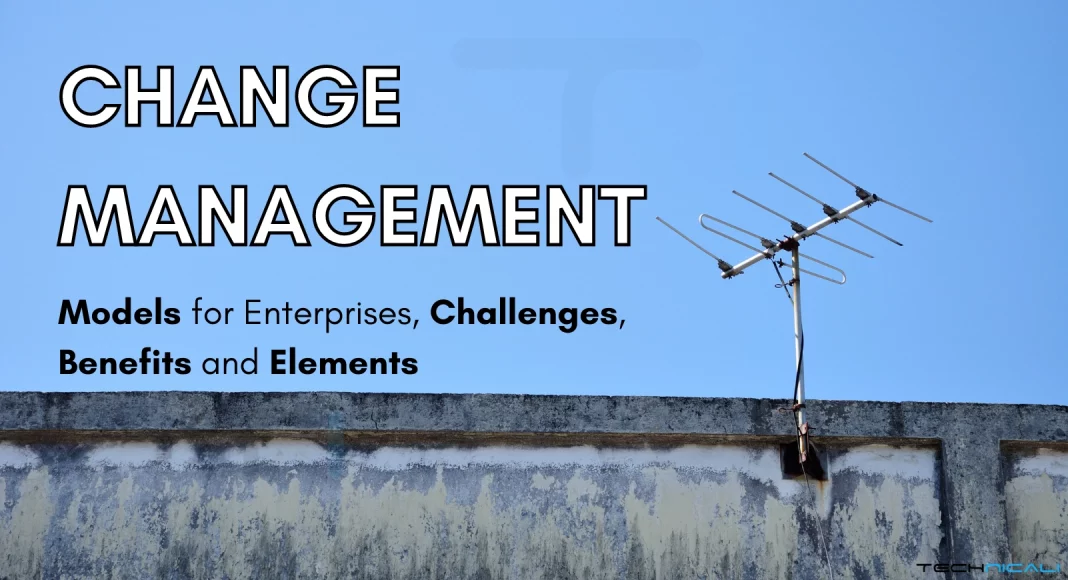You know those days when it feels like everything is going wrong? Your computer crashes, your car won’t start, you spill coffee all over your shirt, and to top it all off, you get a speeding ticket on the way to work. Well, welcome to the world of enterprise change management.
There are many challenges and benefits to consider when undertaking enterprise change management, as well as various models and elements that can be implemented to make the process more effective.
In this post, we will explore all of these aspects in detail.
Contents
What is Enterprise Change Management?
Enterprise change management (ECM) is a systemic approach to managing organisational change that considers the people, processes, and technology involved.
ECM encompasses all aspects of an organisation’s transition from one state to another, whether it be a small change or a large-scale transformation.
ECM is not just about implementing new technologies or systems; it’s about understanding how people will be affected by the changes and ensuring they are prepared for the transition. A successful ECM strategy considers the impact of change on all stakeholders and includes plans for communication, training, and support.
The Challenges of Change Management

Change is inevitable in any organisation, but it can also be disruptive.
Change Management is the process of planning, executing, and monitoring the changes in an organisation. It is a broad discipline that includes everything from small changes to large-scale transformations. Change management is not easy, but it is necessary to keep an organisation running smoothly. Many challenges can arise during a change management initiative, but there are also ways to overcome them.
1. Resistance to Change
People are creatures of habit and often don’t like it when their routine is disrupted. It’s important to remember that resistance is not always bad; sometimes, it can signify that people are attached to their work and care about the company. However, if resistance is left unchecked, it can lead to problems such as employees feeling disengaged or unproductive. Successful change management requires engaging with employees and understanding their concerns. Then only you can address their resistance and ensure they are on board with the changes.
2. Lack of Communication
Whether it’s relationships or work, change can be challenging to communicate, especially if it’s something that people resist. Without clear and concise communication, people can feel lost and confused during a time of change. This can lead to lower morale and productivity and an overall feeling of unease in organisational core competency.
3. Lack of Resources
When implementing change, organisations often don’t access triple constraints and underestimate the time and money needed. This can cause problems such as delays in the project or a decrease in the final product quality, causing cost overruns and a growing feeling of frustration among employees.
I have seen many people in this situation, which is not fun.
Having a realistic change plan that considers all the necessary resources is important.
4. Training and Development
Without proper training, employees may not be able to adequately perform their new roles or may resist the change altogether. Furthermore, employees may become bored or disengaged with their work if they are not allowed to develop their skills. This will further lead to incompetence and a high turnover rate. To avoid these issues, it is essential to provide employees with comprehensive training and development programmes that will equip them with the necessary skills and knowledge to excel in their new roles.
5. Support
Change can be a stressful and overwhelming experience, so employees must have access to support throughout the process. This could include mentorship programs, employee assistance programs, or even regular check-ins with their manager. With Remote Culture, support is more critical than ever, as team members might feel isolated. It has also become easy for employees to get distracted at home with family or other obligations. A solid support system can help reduce stress and ensure everyone is on the same page.
6. Change Fatigue
Too much change can lead to what is known as “change fatigue.” This is when employees become so overwhelmed by the constant changes that they begin to feel burnt out. Change fatigue can lead to a decrease in productivity and an increase in absenteeism. Addressing change management in enterprise resource planning (ERP) systems can help overcome change fatigue and ensure that employees can adapt to the changes quickly and efficiently.
7. Implementation Issues
Even if a change is well-planned and communicated, there can still be many problems while implementing it. This is often due to not having proper models, frameworks and tools in place to manage and monitor the change. ERP Implementation, for instance, can be a huge undertaking that requires significant changes to company culture, processes and systems. If not managed properly, it can lead to widespread disruption on an individual and organisational level.
Models of Change Management

There are many different change management models, but some of the most popular ones include Lewin’s three-stage model, Kotter’s eight-step model, and Bridge’s transition model. A change management model is crucial to establishing and improving organisational change capability.
Here’s a look at each model and how it can be used to manage change effectively:
Lewin’s Three-Stage Model
Lewin’s three-stage model is one of the most widely used change management models. It consists of three stages of the change management process:
- Unfreezing
- Changing
- Refreezing.
The unfreezing stage is when people are first introduced to the change and begin to realise that there is a need for it. This can be difficult because people may resist the change and try to hold on to their old ways of doing things.
The changing stage is when people actually start to implement the change. This is often the most difficult stage because it can be disruptive, and people may not know how to do things differently. In this stage, it’s better to have a holistic approach, as this would help reduce the resistance.
The refreezing stage is when the change becomes part of the new normal, and people are comfortable with it. This stage is vital because it helps to ensure that the change sticks and doesn’t just revert back to the old ways of doing things. The End User Training in the simple answer for this stage.
Kotter’s Eight-Step Model
Kotter’s eight-step model is a widely used change management model. It was first introduced by John Kotter in 1995, but it has gained wide popularity in the past decade.
The model consists of eight steps that should be taken to manage change effectively:
- Establish a sense of urgency
- Forming a guiding coalition
- Develop a vision and strategy
- Communicate the change vision
- Empower broad-based action
- Generate short-term wins
- Consolidate gains and produce more change
- Institutionalise new approaches
The first step, creating a sense of urgency, is crucial because it helps to get people on board with the change. This can be done by communicating the need for change and showing what will happen if the change isn’t made.
The second step, forming a guiding coalition, is important because it helps to get the right people on board to lead the change. This includes identifying people who are committed to the change and appointing them to leadership positions.
The third step, developing a vision and strategy, is essential because it helps to provide direction for the change. This includes creating a shared vision for the future and developing a plan for how to achieve it.
The fourth step, communicating the change vision, is vital because it helps ensure everyone is on the same page. This includes sharing the vision with employees and getting their feedback.
The fifth step, empowering employees to act on the vision, is crucial because it helps to ensure that employees are bought into the change. This includes giving employees the resources and authority to make changes.
The sixth step, generating short-term wins, is important because it helps to keep employees motivated. This includes setting goals and celebrating when they are achieved.
The seventh step, consolidating gains and producing more change, is important because it helps ensure the change sticks. This includes reviewing the progress made and making adjustments as needed.
The eighth step is institutionalising change management with new approaches for a successful implementation of the future state as it helps the change to become part of the culture in the entire organisation. This includes creating policies, structured processes and step-by-step instructions supporting the transition and ensuring that employees are held accountable for delivering objectives.
Bridge’s Transition Model
Bridge’s transition model is a less widely used change management model, but because it is another effective change management system, it’s still worth mentioning.
It consists of three phases:
- Ending
- Neutral Zone
- A new beginning
The ending phase is when people start to come to terms with the change and begin to let go of the old ways of doing things. This can be a difficult phase because it can be emotionally charged. It revolves around the strategic capability to let go and develop new skills for greater success.
The neutral zone is when people are in limbo and aren’t sure what the future holds. The main pain point here is people here are neither fully committed to the change nor opposed to change. This is often the most prolonged phase of the change process. The key to this phase is to keep communication open, and people informed about what is happening.
The new beginning phase is when people start to embrace the change and adopt new ways of doing things. This phase is essential because it helps to ensure that the change sticks and doesn’t just revert back to the old ways of doing things. In this stage, end-user training helps employees understand how to use and get comfortable with the new system.
All three models are effective in their own ways and can be used depending on the situation and project objectives.
The most important thing is to choose a model that can be an integral part of building change management that can get buy-in from employees and help to make the change successful.
Organisational Change Management = Managing to Change the World.

The world is constantly changing, and so are the businesses in it. To stay ahead of the competition, enterprises need to be able to effectively manage.
The most prominent example was the Covid-19 Pandemic; the companies with robust change management frameworks in place could adapt to the new remote normal much faster than those that didn’t have a proper change management strategy. Another example is how E-commerce took over the shopping experience. Companies like Amazon and Shopify, which had shifted their focus early on to E-commerce, reaped the benefits while those who didn’t struggle to keep up.
The Benefits of Change Management in ERP Implementation

While the above shocking image is somewhat exaggerated, I’m sure you will have the same reactions after reading the below benefits.
There are many benefits to having a solid change management strategy in place.
1. Agility and Responsiveness
Change management helps businesses be more agile and responsive to the ever-changing world. By having a plan in place for how to deal with change, companies can adapt quickly and make the necessary changes without disrupting their operations.
2. Improved Efficiency Of Change Control
Change management can help businesses to improve their efficiency by streamlining the process of making changes. By having a set process in place, companies can avoid duplication of effort and save time. Change management can also help to improve communication and coordination between different departments within a business. This can lead to a better overall understanding of the changes that need to be made and how they will impact the industry as a whole.
3. Enhanced Customer Satisfaction
Change management can help businesses enhance customer satisfaction by ensuring that changes are made to meet their needs and expectations. By involving customers in the change process, companies can get feedback on what they want and need from the changes. This feedback can then be used to make the changes more effective and tailored to the customers’ needs.
4. Reducing Enterprise Costs
Change management can help businesses to reduce their costs by making sure that changes are made in a way that is efficient and effective. By streamlining the change process, businesses can avoid duplication of effort and waste. Change management can also help companies to avoid making changes that are not necessary or that will not be successful. This can save businesses time, money, and resources.
5. Improved Employee Engagement
Change management can help businesses to improve employee engagement by involving employees in the change process. This can help employees to feel more ownership over the changes and make them more invested in the success of the changes. Additionally, by involving employees in the change process, businesses can get feedback on what they want and need from the changes. This feedback can then be used to make the changes more effective and tailored to the needs of the employees.
6. Increased Enterprise Innovation
Change management can help businesses increase innovation by encouraging employees to think outside the box and develop new ideas. By involving employees in the change process, businesses can create an environment that is conducive to creativity and innovation. Additionally, by providing employees with the resources and support they need to make changes, companies can encourage them to take risks and experiment with new ideas.
7. Improved Business Continuity
Change management can help businesses to improve their business continuity by ensuring that changes are made in a way that does not disrupt operations. Enterprises can make the necessary changes without disrupting their operations by having a plan in place for how to deal with change. Additionally, by involving employees in the change process, businesses can get feedback on what they want and need from the changes. This feedback can then be used to make the changes more effective and tailored to the needs of the business.
8. Agility in Organisations
Agility with ERP systems is key to success in the ever-changing business world. Agile Change management can help businesses to be more agile and manage various services by making sure that changes are made in a way that is efficient and effective. By streamlining the change process and implementing a version control system, businesses can avoid duplication of effort and waste. Change management can also help companies to avoid making changes that are not necessary or that will not be successful. This can save businesses money, resources and time by managing the speed of change.
9. Enhanced Enterprise Financial and Strategic Performance
Change management can help businesses to enhance their financial and strategic performance by making sure that changes are made in a way that is efficient and effective. An ERP system helps you visualise the data, align resources, and manage the end-to-end process. This allows you to make changes with confidence and minimise risk.
10. Managing Transitions
Transitions can be one of the most difficult aspects of change management. It can also help businesses to avoid making changes that are not necessary or that will not be successful. Types of transitions include, but are not limited to, changes in leadership, changes in ownership, changes in strategy, and changes in culture.
The way Change management occurs today can be applied to every area of a business, from IT and operations to marketing and human resources.
So we must discuss the Elements of Organisational Change that can help leading organisations apply change management or eliminate change saturation for enterprise-wide project success.
What are the 4 Major Elements of Organisational Change?

The 4 major elements of organisational change are:
- Strategy
- People
- Process
- Technology
Strategy refers to a business’s overall plan or model for making changes. This could be a long-term plan for slowly introducing(constant change) changes over time or a more immediate objective for making radical changes quickly.
People are the employees and customers who will be affected by the changes. It is essential to involve them in the change process so that they can understand the changes and how they will be affected by them.
Processes are the systems and procedures that a business uses to make changes. These need to be well-designed and efficient to make changes quickly and smoothly.
Technology is the tools and systems that a business uses to support the change process. This could include enterprise software, knowledge management, project management, collaboration tools, cloud-based services, and mobile apps. Our Technicali team has compiled a list of the seven best ERP software with organisational change capability; check out:

Failing to plan for any of these four components can lead to problems with the change process.
For example, if a business does not have a clear strategy for making changes, it may make changes that are not well-thought-out or that do not fit with the overall goals of the business. Or, if a business does not involve people in the change process, employees may resist the changes or be unaware of how they will be affected by them.
Additionally, if procedures are not well-designed, changes may take longer or may not be implemented correctly. Similarly, if technology is not up to date or not well integrated, it could hamper the change process.
Closing Words
While Change Management is vital for the success of any project, it is not always easy to implement. There are several factors to consider, and I hope this guide wasn’t too difficult to read. If it was, just bookmark this page so you can come back later when you have more time.
Over to you, have you had any experience implementing change management in your organisation? If so, what lessons did you learn? Please share your experiences and advice by tweeting me on my handle @TheMarkFarrar
If you enjoyed this article, please share it with others who may find it useful.
Cheers!

